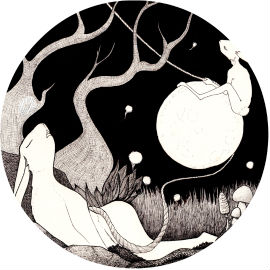
Saint Barbara. c1420. French. Oak. The statue was once brightly coloured/painted. Traces of red paint on her dress highlight her status as a martyr of the Christian faith. In this image, you can see the characteristic S-curve typical of the Beautiful or International style of the 1400s.
A beautiful oak carving of Saint Barbara was purchased by the NGV in 1945, the last year of the war. She was first put on display in the Buvelot Gallery in February, 1946. In the National Gallery of Victoria’s quarterly bulletin (Volume II, No I, 1946) Daryl Lindsay* writes:

Detail showing some of the beautiful detail of the statue, including the folds of the gown at the neckline, the pages of the book, and the ‘delicate hand’ noted by Daryl Lindsay.
Barbara fell ill with longing to embrace the Christian faith. Her father, concerned at her failing health, delivered a physician to the room at the top of the tower, but the physician was a doctor of the soul, not of the body. He gave Barbara instruction, and baptised her in the name of the father, son and holy spirit.

Barbara’s exquisite face, with its high brow. Barbara was said to be a very beautiful daughter. This is one of the reasons her father imprisoned her in the power. Note the long hair (by which her father grasped her when he finally executed her) and the detail of the head piece.
Barbara was dragged back to the prefecture and held to trial by the prefect, Martinianus. She was paraded naked through the town, but the angels concealed her in a mystical fog. She was tortured each day, but overnight all of her horrific wounds healed. She was bound and stripped to be burned at the stake, but the torches were blown out by the breath of the angels. Each injury and attempt on her life that she survived only made the lady more radiant. Finally, in a rage, her father grasped Barbara’s long, golden hair, and hacked off her head.

Detail of the tower, showing the three windows Barbara had installed to remind her of the ‘three names of God’. The tower also serves a structural purpose in the statue.


I loved seeing this with you. She is stunning!
She is a beautiful carving. I try to visit her whenever I'm in town ????